 |
 |
 |
| |
Pharmacokinetics and pharmacodynamics of the NNRTI etravirine (ETR; TMC125) in treatment-experienced HIV-1-infected patients: pooled 24-week results of DUET-1 and DUET-2
|
| |
| |
Reported by Jules Levin
CROI 2008, Boston
Thomas N Kakuda,1 Janet R Wade,2 Eric Snoeck,2 Monika Peeters,3 Chris Corbett,3 Goedele De Smedt,3 Lorant Leopold,1 Johan Vingerhoets,3 Brian J Woodfall,3 Richard MW Hoetelmans3
1Tibotec Inc., Yardley, PA, USA; 2Exprimo NV, Mechelen, Belgium; 3Tibotec BVBA, Mechelen, Belgium
ABSTRACT
Background
ETR is a next-generation NNRTI with potent activity against both wildtype and NNRTI-resistant HIV. DUET-1 and DUET-2 are identically designed, ongoing Phase III, double-blind, randomized trials of ETR versus placebo, both with a background regimen (BR) including darunavir/ritonavir (DRV/r) and other antiretrovirals in treatmentexperienced patients. In the pooled intent-to-treat (ITT) population at 24 weeks (n=1203), ETR was consistently superior to placebo with respect to the following endpoints: confirmed viral load (VL) of <50 copies/mL (59 vs 41%), VL of <400 copies/mL (74 vs 53%) and mean VL reduction (2.4 vs 1.7 log10 copies/mL) (all p<0.0001). This analysis investigated demographic effects on pharmacokinetics and pharmacokinetic/pharmacodynamic (PK/PD) relationships from these trials.
Methods
A population PK model for the ETR Phase III formulation was developed with Bayesian feedback for area under the plasma concentration-time curve (AUC12h) and predose plasma concentration (C0h) from sparse sampling collected over 24 weeks in the main study and from intensive pharmacokinetics in a substudy. ANCOVA, logistic regression and generalized additive modeling (GAM) were used to analyze the PK/PD relationships with efficacy endpoints and safety.
Results
Of the 1203 patients enrolled, 599 were randomized to ETR and PK data from 574 were available. The estimated ETR population mean (standard deviation; SD) AUC12h and C0h were 5501 (4544) ng·h/mL and 393 (378) ng/mL, respectively. Clearance (CL/F) was estimated to be 43.7L/h and intersubject variability on CL/F was 60%; intrasubject variability on fraction absorbed was 40%.
Covariate analysis including sex, age, weight, race, creatinine clearance (CrCL), viral hepatitis status, and use of tenofovir (TDF) or enfuvirtide (ENF) in the BR showed that none of these factors significantly impacted ETR pharmacokinetics.
ETR AUC12h or C0h was not associated with the primary endpoint of reaching <50 copies/mL at Week 24. Other factors including baseline VL and CD4, use of active agents, fold-change in EC50 to DRV and ETR, and adherence are more important determinants than pharmacokinetics. No apparent relationships were seen between ETR pharmacokinetics and laboratory changes or adverse events (AEs).
AUTHOR CONCLUSIONS
· ETR 200mg bid demonstrated superior activity compared to placebo in this treatment-experienced patient population
· Moderate to high inter- and intrapatient variability in ETR pharmacokinetics
- increase in CL/F with TDF not considered clinically relevant
· ETR AUC12h or C0h was not associated with the primary endpoint of reaching <50 copies/mL at Week 24
- prognostic factors retained in the final model (BCD4, BVL, use of active agents, adherence, FCDRV and FCETR) are more important determinants than pharmacokinetics
· No apparent relationships were seen between pharmacokinetics and AEs or laboratory changes
-- rash does not appear to be related to ETR AUC12h
INTRODUCTION
ETR is a next generation NNRTI with potentin-viro activity against both wild-type and NNRTI-resistant HIV-1
PK Characteristics
--ETR must be administered following a meal:
AUC12th decreased 51% under fasting conditions (PI says 350 calories)
---highly protein bound (1005 to both albumin and a1-acid glycoprotein (orosomucoid)
--substrate and inducerof CYP3A
--substrate and inhibitor of CYP2C9 and 2C19
--minimal (<1.2%) renal excretion
--mean terminal elimination t1/2 of 41 hours.
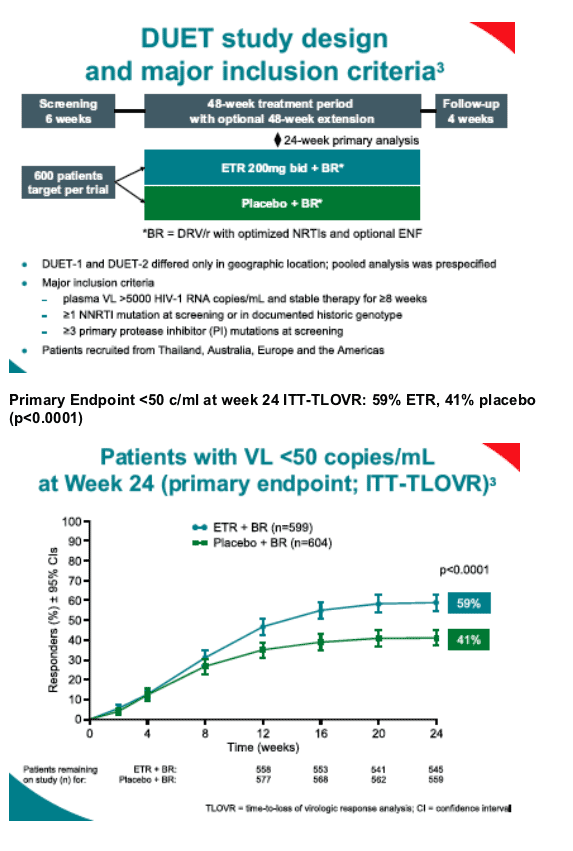
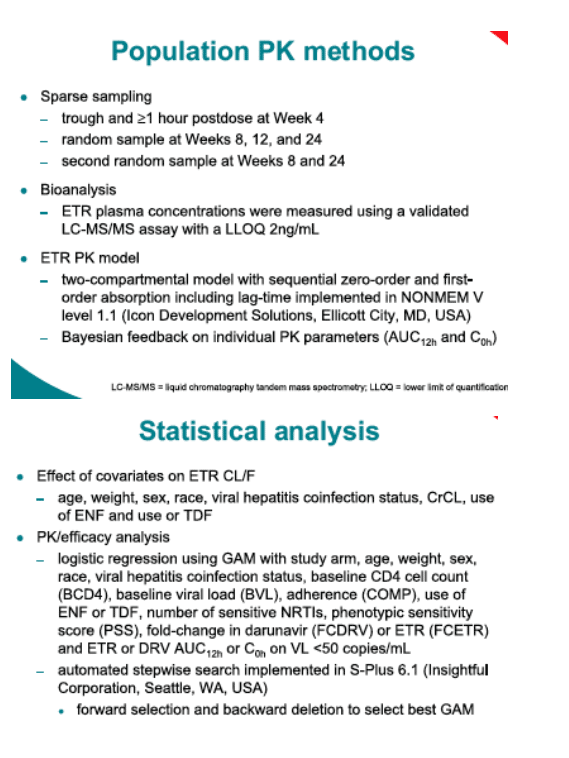
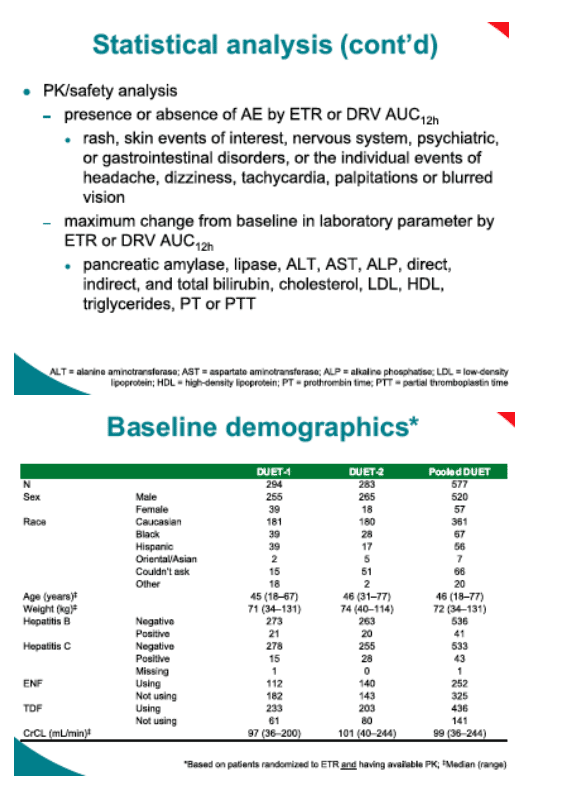
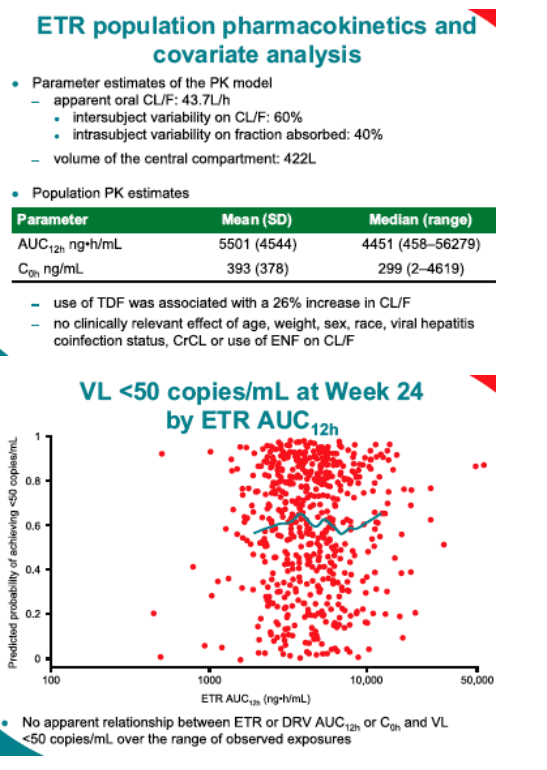
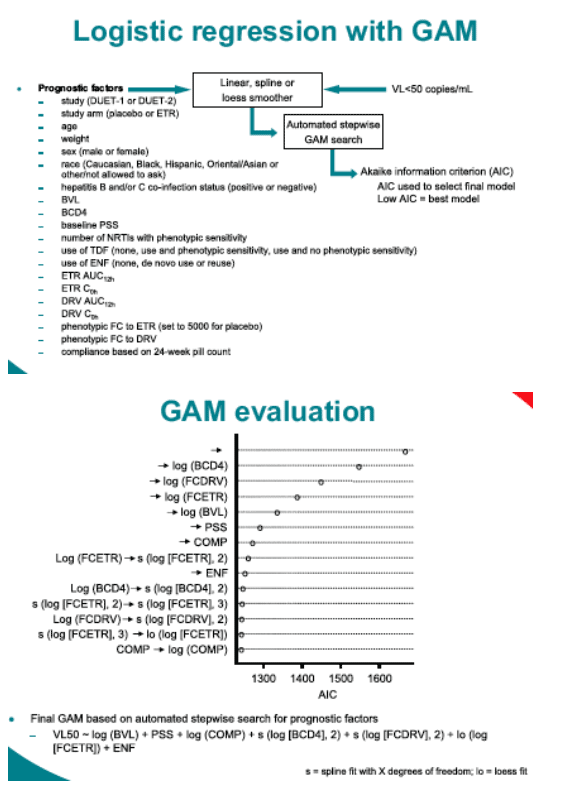
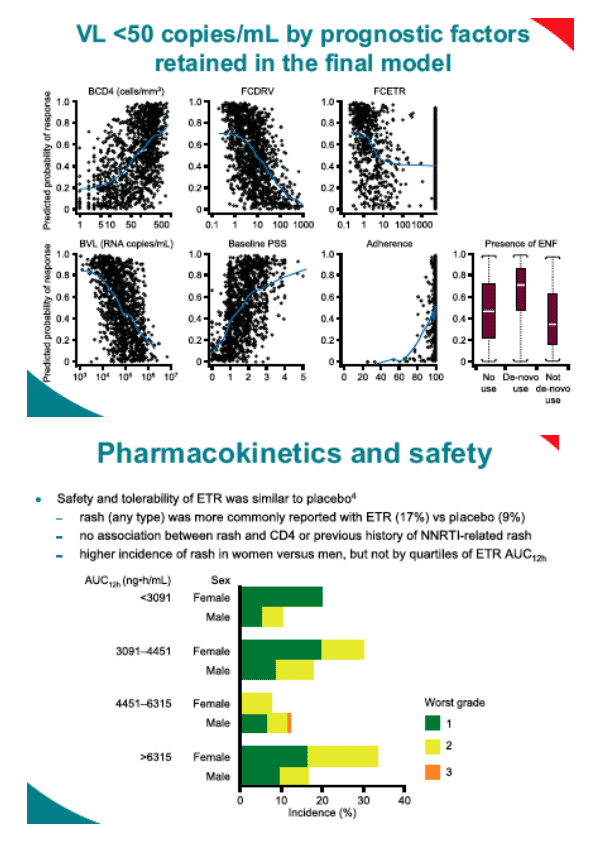

REFERENCES
1. Vingerhoets J, et al. J Virol 2005;79:12773-82.
2. INTELENCETM package insert.
3. Hicks C, et al. IDSA 2007. Abstract 1316.
4. Haubrich R, et al. IDSA 2007. Abstract 1210.
|
| |
|
 |
 |
|
|